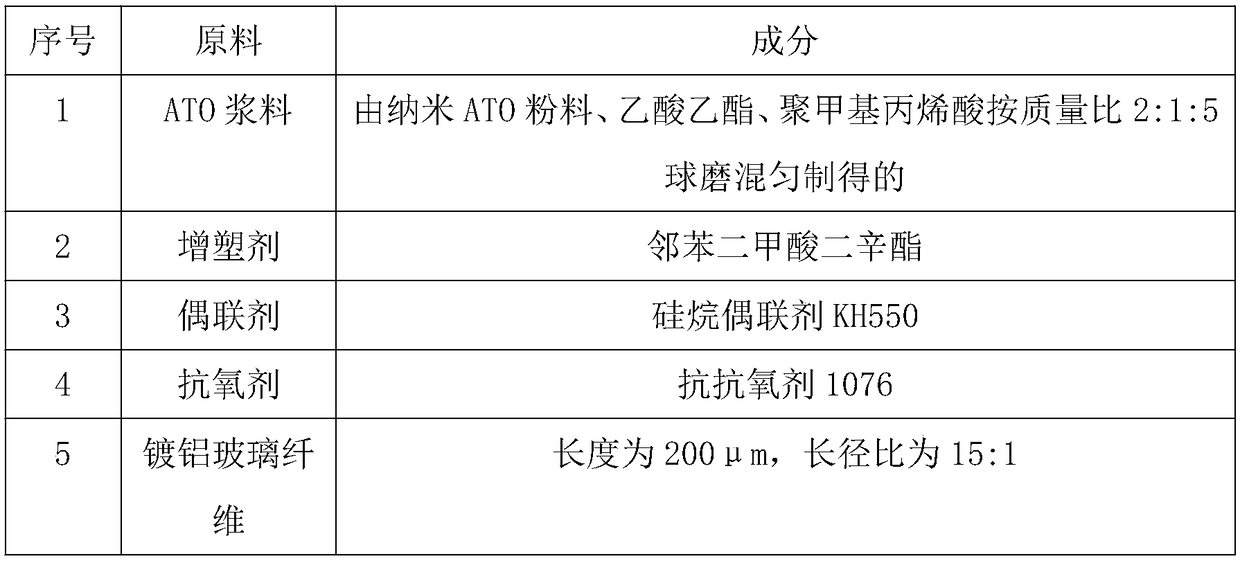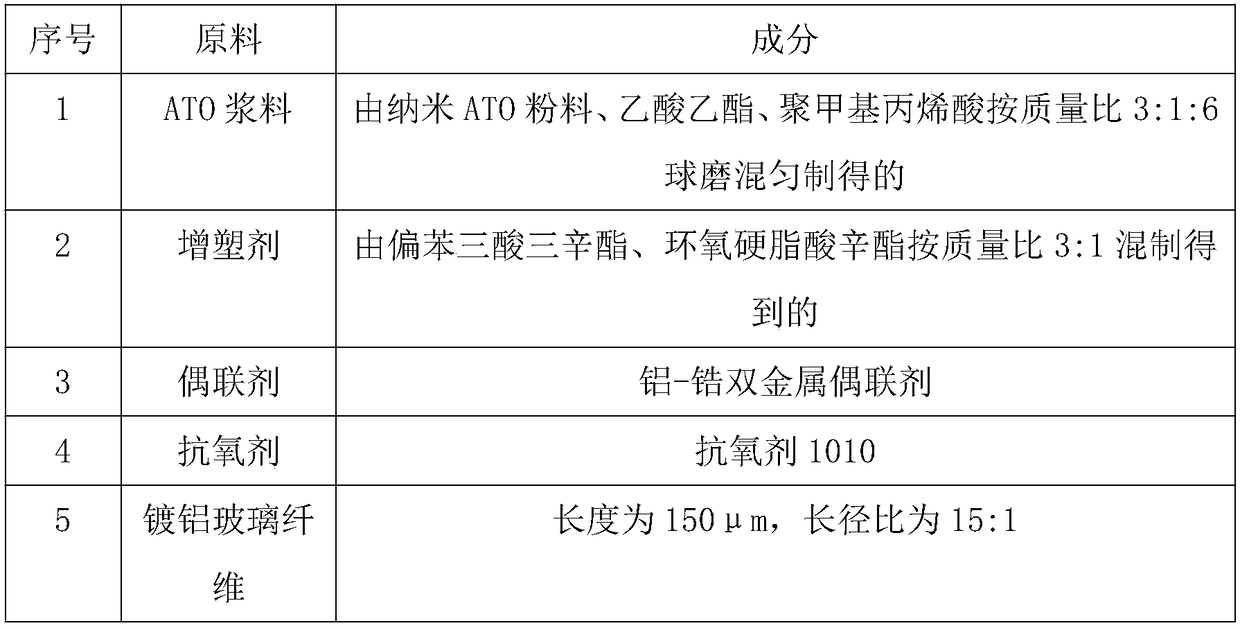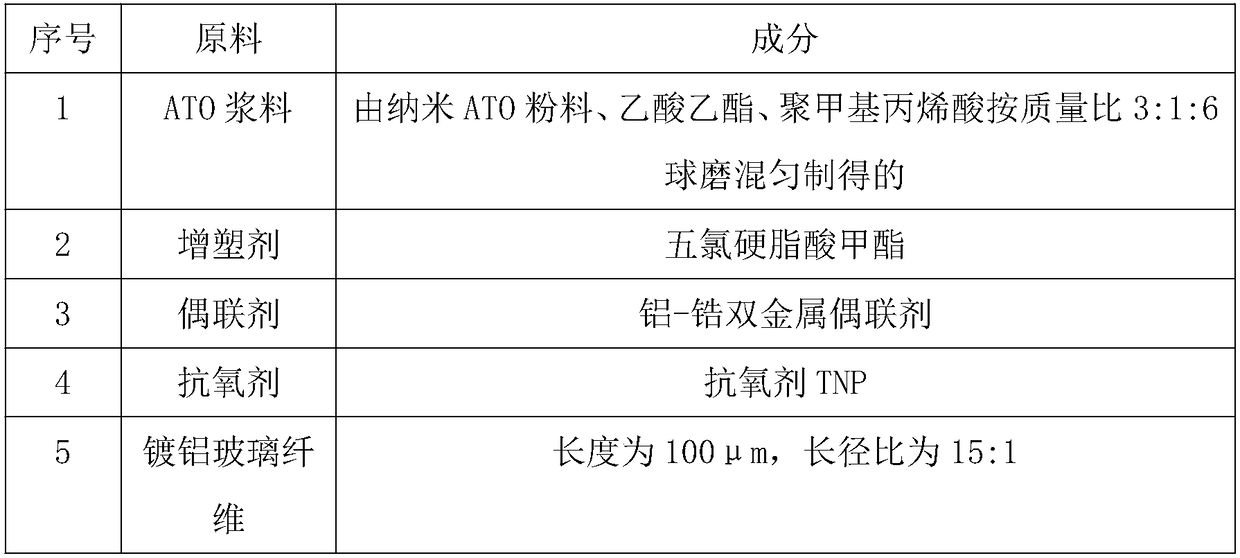Common-mode interference reduction type transmission cable for computers
A transmission cable and common mode interference technology, applied in the field of computer transmission cables, can solve problems such as common mode interference and wire signal crosstalk, and achieve the effects of long service life, good volume resistivity, and convenient transportation and construction.
- Summary
- Abstract
- Description
- Claims
- Application Information
AI Technical Summary
Problems solved by technology
Method used
Image
Examples
Embodiment 1
[0030] A computer transmission cable for reducing common-mode interference, comprising an anti-interference layer, the anti-interference layer includes the following raw materials in parts by weight: 40 parts of natural rubber, 25 parts of TPE resin, styrene-butadiene block copolymer 10 parts, 6 parts of polyether polyurethane with a molecular weight of 600, 4 parts of ATO slurry, 1 part of aluminized glass fiber, 1 part of nano-aluminum nitride powder, 0.8 parts of erucamide, 0.4 parts of diphenyl phosphate, 0.3 parts of zinc borate 2 parts, 2 parts of plasticizer, 0.8 part of coupling agent and 1.5 parts of antioxidant;
[0031] The preparation of the above-mentioned ATO slurry and the selection of external additives are shown in Table 1 below
[0032] Table 1
[0033]
[0034] The preparation method of the above-mentioned anti-interference layer comprises the following steps:
[0035] (1) Mix the above-mentioned weighed raw materials through the following stages
[00...
Embodiment 2
[0042] A computer transmission cable for reducing common-mode interference, comprising an anti-interference layer, the anti-interference layer includes the following raw materials in parts by weight: 45 parts of natural rubber, 30 parts of TPE resin, styrene-butadiene block copolymer 12 parts, 7 parts of polyether polyurethane with a molecular weight of 700, 5 parts of ATO slurry, 1.5 parts of aluminized glass fiber, 1.25 parts of nano-aluminum nitride powder, 1 part of erucamide, 0.5 parts of diphenyl phosphate, 0.4 parts of zinc borate part, 2.5 parts of plasticizer, 0.9 part of coupling agent and 2 parts of antioxidant;
[0043] The preparation of the above-mentioned ATO slurry and the selection of external additives are shown in Table 2 below
[0044] Table 2
[0045]
[0046] The preparation method of the above-mentioned anti-interference layer comprises the following steps:
[0047] (1) Mix the above-mentioned weighed raw materials through the following stages
[0...
Embodiment 3
[0054]A computer transmission cable for reducing common-mode interference, comprising an anti-interference layer, the anti-interference layer includes the following raw materials in parts by weight: 50 parts of natural rubber, 35 parts of TPE resin, styrene-butadiene block copolymer 15 parts, 8 parts of polyether polyurethane with a molecular weight of 700, 6 parts of ATO slurry, 2 parts of aluminized glass fiber, 1.5 parts of nano-aluminum nitride powder, 1.2 parts of erucamide, 0.6 parts of diphenyl phosphate, 0.5 parts of zinc borate 1 part, 3 parts of plasticizer, 1 part of coupling agent and 2.5 parts of antioxidant;
[0055] The preparation of the above-mentioned ATO slurry and the selection of external additives are shown in Table 3 below
[0056] table 3
[0057]
[0058] The preparation method of the above-mentioned anti-interference layer comprises the following steps:
[0059] (1) Mix the above-mentioned weighed raw materials through the following stages
[00...
PUM
 Login to View More
Login to View More Abstract
Description
Claims
Application Information
 Login to View More
Login to View More - R&D
- Intellectual Property
- Life Sciences
- Materials
- Tech Scout
- Unparalleled Data Quality
- Higher Quality Content
- 60% Fewer Hallucinations
Browse by: Latest US Patents, China's latest patents, Technical Efficacy Thesaurus, Application Domain, Technology Topic, Popular Technical Reports.
© 2025 PatSnap. All rights reserved.Legal|Privacy policy|Modern Slavery Act Transparency Statement|Sitemap|About US| Contact US: help@patsnap.com



